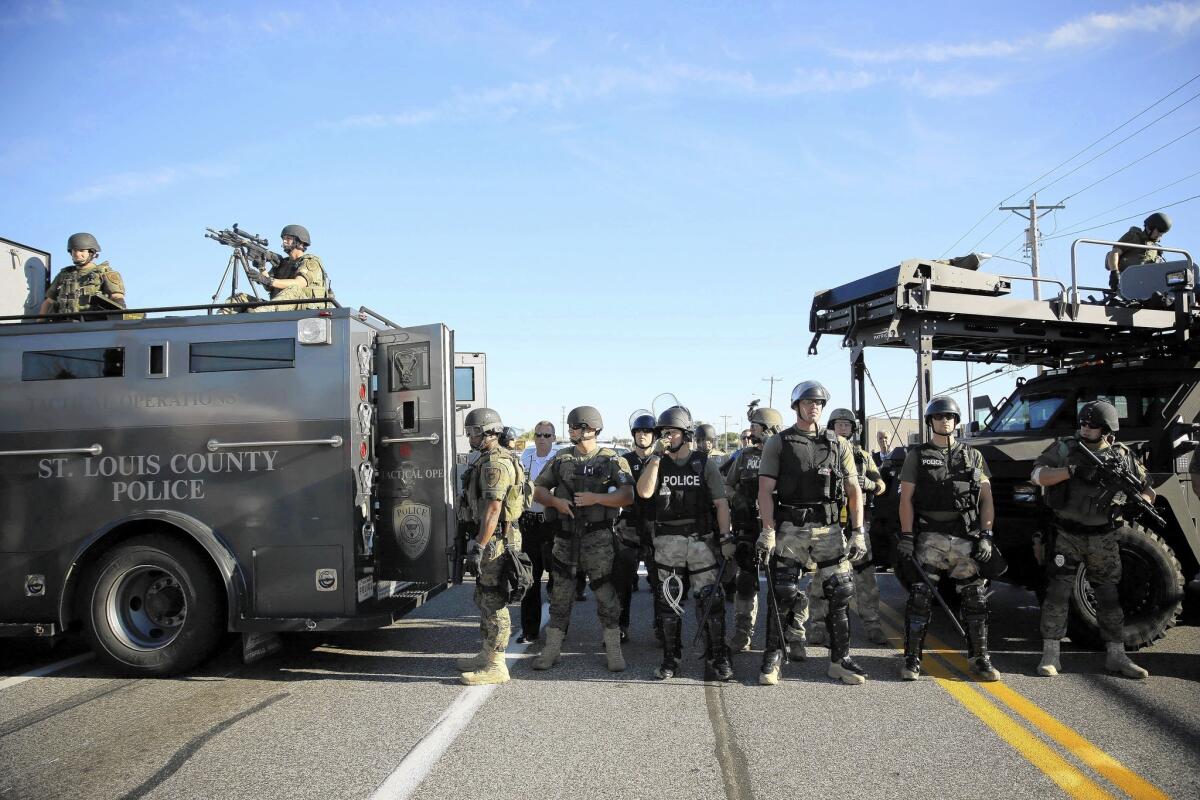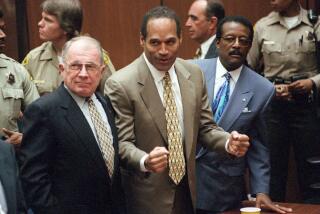Growing police use of military equipment faces scrutiny

Reporting from Washington — The image of Ferguson, Mo., police officers in camouflage pointing high-caliber rifles from armored vehicles at unarmed protesters has crystallized a debate over whether a decades-long flow of military-grade equipment to the nation’s police departments has gone too far.
On both left and right, political figures as varied as Atty. Gen. Eric H. Holder Jr. and Sen. Rand Paul (R-Ky.) pointed to Ferguson, denouncing what Holder referred to this week as “unnecessarily extreme displays of force” by police.
That debate fits into a larger pattern: A huge upsurge of mayhem in the 1970s and 1980s led to tough-on-crime measures across the country. Now, after two decades of improvements in most places, policies such as long, mandatory prison sentences and expansions of police surveillance are being questioned.
The use of military-style equipment by even small-town police departments is the latest tactic to come under scrutiny.
For years, the money and equipment has flowed copiously. Since 1995, the Pentagon has distributed $5.1 billion in surplus military equipment to U.S. police departments — sleeping bags, cameras and office equipment, but also assault rifles, mine-resistant armored personnel carriers and helicopters, said Pentagon spokesman Mark Wright.
The goods come free of charge except for the cost of picking them up.
The Department of Homeland Security gives more than $1 billion a year to state and local police, much of it for equipment.
This year, the Pentagon program is up for what would normally have been a noncontroversial renewal. An effort in the House to repeal it failed this summer by a lopsided 355-62 vote.
Friday, however, Senate Armed Services Committee Chairman Carl Levin (D-Mich.) said the program needed to be reviewed “to determine if equipment provided by the Defense Department is being used as intended.”
In an age of mass shootings and terrorist threats, with local budgets flat, police chiefs face a huge temptation to fill their arsenals with federal largess, said Jim Bueermann, president of the Police Foundation and a former chief in Redlands.
“A lot of departments jumped at the opportunity to acquire things they normally could not afford,” Bueermann said. But “just because we can get the equipment, it doesn’t mean we should use it.”
In some cases, the pitfalls become quickly apparent.
Last year, the small police department of Banning ordered an 18-ton tank complete with gun turret. A police sergeant was assigned to pick up the vehicle and drive it home. Along the way, he blew a tire on Interstate 10 in southern Arizona, careened across the roadway, totaled a pickup and knocked out the windshield of another vehicle.
No one was injured, but the accident cost Banning $42,000. Angry city officials and residents demanded to know why police needed a tank.
In other cases, departments have acquired equipment they could not afford to maintain. For some armored vehicles, “a tire can cost $10,000 or $12,000” to replace, said Mark Lomax, executive director of the National Tactical Officers Assn., a nonprofit group based in Doylestown, Pa., that trains SWAT teams.
Los Angeles Deputy Chief Mike Downing, who oversees counter-terrorism and other special operations, noted in a recent report that police SWAT teams, created in the 1960s, have morphed into military battalions.
Police departments that seek “to justify their existence and budgets” often begin using heavy equipment for relatively routine missions such as serving warrants, he said. That has become “a dangerous and unnecessary temptation.”
Departments need to ask, “Do we need the type of weapon they are offering?” said Chris Nanos, chief deputy of the Pima County Sheriff’s Department in southern Arizona. “A 14-ton armored vehicle? I don’t know what you would do with that.”
Lack of training and leadership can be as big a problem as excessive equipment, said Ron McCarthy, a former Los Angeles police SWAT team supervisor who now works as a consultant for police departments.
“If you’re not going to provide the appropriate training, you shouldn’t have the equipment,” McCarthy said.
Armored vehicles, military uniforms, assault rifles and police dogs escalated tensions in Ferguson, he said, adding that the equipment should have been on standby, out of view, but ready to respond quickly if needed.
Still, he and other police experts said that military-grade equipment has an important role when used properly.
Eugene O’Donnell, professor of law and police studies at John Jay College of Criminal Justice in New York, said some critics were “in denial” about the need for police to use force.
“This week’s story is police overreaction. Next week’s story is going to be police under-reaction,” O’Donnell said.
The events in Ferguson showed that “there are going to have to be serious strings attached to handing out military weaponry,” he said. “There are 18,000 police departments in the U.S., and some of those police departments are scary places indeed.”
But, he said, “the power of looting and rioting to destroy a city is not to be sneezed at. School shootings and heavily armed people are a fact of life, and, like it or not, terrorism hangs over us.”
Some police departments already have begun rolling back the militarized approach, with the LAPD in the forefront.
The turning point came in May 2007, when hundreds of LAPD officers swept through the city’s MacArthur Park in a poorly orchestrated, chaotic attempt to clear out a large gathering of immigrant rights protesters. Officers fired scores of rubber bullets and struck protesters with batons as they pushed through park.
After an internal investigation found poor planning and training and ineffective control by commanders, then-Chief William J. Bratton ordered the entire department retrained in crowd-control measures.
Today, the department takes a far more patient approach. Its reworked tactics were on display during the Occupy movement in 2011, when thousands of protesters turned the lawn surrounding City Hall into a tent city. As police in other cities clashed violently with protesters, the LAPD took a hands-off approach.
But the LAPD has been an exception, said Jody Armour, a law professor at USC who studies police use of force.
“Using this equipment tactically, using it sparingly and wisely is a very hard thing to do,” he said.
“When it’s possible to get your hands on something for cheap or even for free that would otherwise be unattainable,” he said, “it’s hard to say no.”
Times staff writers Brian Bennett, David Lauter and Timothy M. Phelps in Washington, Cindy Carcamo in Phoenix and Alan Zarembo in Los Angeles contributed to this report.
More to Read
Sign up for Essential California
The most important California stories and recommendations in your inbox every morning.
You may occasionally receive promotional content from the Los Angeles Times.













